Dead to Rights Preview
We travel to Namco and get the big scoop on its upcoming US-developed action game, Dead to Rights.
Namco Hometek hired senior producer Andre Emerson to create an action-adventure game. Noting the successes of games like Metal Gear Solid, Syphon Filter, Resident Evil, and the like, the prestigious Japanese publisher/developer perceived a huge gap in its catalog. It's that gap both Emerson and Namco are hoping to fill with Dead to Rights, the US-developed third-person action game due out next year. And by all accounts, the game seems very much primed for the job.
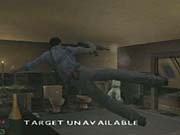
Essentially, Dead to Rights is a third-person bullet-fest, in the spirit of games like C-12 and Syphon Filter. It's the game's themes, though--and how they directly influence its gameplay--that really set it apart. Dead to Rights is heavily informed by the visual and stylistic language of Hong Kong action films, which are characterized by intense, almost balletic action sequences and are populated by characters packing endless supplies of guns and ammunition, often wielding one weapon per hand. The game's story is driven by the same hallmarks of the Hong Kong action flick--themes of revenge, redemption, and aggressive heroism--and, more importantly, the game's play mechanics are built around the intense visual action that's fascinated fans of the style. "Our character does things with far less subtlety than you'd find in a lot of other products," Mr. Emerson boldly stated, putting it best. Protagonist Jack Slate, fugitive ex-cop and expert killer, literally flies through the battlefield, wielding two handguns as well as he does a rifle, and when need dictates, he snaps foes' necks and snatches the hardware from their fallen bodies. And due to the game's tight control scheme and masterfully designed play mechanics, doing it all feels just as compelling as it looks.
Even at this early point, everything about the game seems as well polished as it is well conceived. And even to someone who's only casually versed in the Hong Kong action style, it's obvious that the team knows the drill quite well. It's easy to see that such an environment would make for a great product. "Rather than say, 'Hey, let's make the Hong Kong action game that's essentially Doom with a paint job' or something, I truly spent time revisiting the films that I really loved anyway, and I tried to look at those and see what about their pacing it is that works so well," Emerson explained. The effect is apparent--where so many developers simply dress a generic game design with the trappings of a certain visual style, the Dead to Rights team examined its chosen focus, found its most compelling potential gameplay elements, and worked them into a strong game system. The result is a game that plays as well as it looks, and it serves as a genuine extension of the Hong Kong action film, faithfully representing it in a 3D gameworld. And the diversity of experiences that the game offers will help ensure that its contribution is enduring. "What we want to do is make this feel like a story-inspired action flick. To do that, there are lots of challenges outside the moment-to-moment shooting and traversal that I think need to make their way in. We've done tons of these kinds of things," Emerson told us, definitely whetting our appetites for what we were about to see."Our character does things with far less subtlety than you'd find in a lot of other products."- Andre Emerson, Senior Producer
Heroic Neck Snapping
| Essential Viewing | |||
| |||
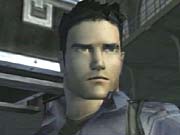
Flint Dille--a genuine Hollywood screenwriter, of G.I. Joe fame--helped Emerson develop the game's story, and he promises it will touch on a whole bunch of deep themes. That Dille is as much a gamer as a screenwriter can only help. "It really becomes more of a deep, film noir story of corruption, crime, and betrayal, and it's a kind of a very rich labyrinth of crime that deals with political issues in the city, things that have been going on with Jack and his family, and things that have been going on in the city for years and years," Emerson said. "It's really a rich tale, and working with Flint Dille has been incredible--he's not a screenwriter who just dumped this script our laps. His work dates back to the old Dungeons & Dragons modules; he's an old-school gamer, but he also happens to be a Hollywood filmmaker." He went on to state that the term "level" isn't a very good description of the game's subdivisions, preferring to call them "chapters." This alludes to the team's desire to make sure that Dead to Rights emerges, above all, as cohesive narrative experience, rather than just the shell of one wrapped around a cool game design. "Overall, the product is inspired more by film, and secondarily by music, than video games," he explained. "Nothing against games, but the kinds of emotions that music and film tap into are something that games have only recently begun tapping into." Hopefully, Dead to Rights will strike the chords he feels other games fail to.
Jack Moves
Jack Slate is one of the coolest characters we've gotten to control in recent times. As Emerson has mentioned on numerous occasions, the Dead to Rights team delved deeply into the canon of Hong Kong action for inspiration for the game's story and its play mechanics. Designing a character with a move set as dynamic as Jack's is definitely an infinitely complex task, as Emerson made clear: "We're constantly trying to refine Jack's animations. We keep giving him more personality because, for us, it's not just about creating this large set of animations and saying, 'We're done.' It's about trying to craft a character that we can build around. And it's not just about creating a move that looks good, but one that works well around the physical dimensions of this character."
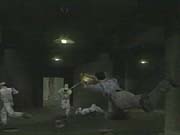
All the work seems to have paid off. Jack Slate can wield two pistols smartly and effortlessly, he can dive in any direction, and he can even target and fire on two foes simultaneously, among other things. What's especially inspiring, though, is that it's all done through a solid and often inventive control scheme. Shooting is achieved by means of the X button, simply enough. Depending on how quick your inputs are, though, Jack will fire with either one or both of his guns. The circle button enacts certain context-specific commands, some of which include the cooler things Jack can do. Press the circle button when you're unarmed and behind an enemy, for instance, and you'll brutally snap his neck and take his weapon. Do it while you're armed, on the other hand, and you'll grab him from behind and use him as human shield, making his life bar your own. Some of the more over-the-top moves are accompanied by a small cutscene that renders the brutal act in full detail. But you can control even that--again, depending on how long you hold the circle button down, the game will either render the action in a short real-time burst or a full two-second in-game cinematic. Emerson explained why it's thus: "Ultimately, we didn't want to just do a lot of canned sequences that made it feel as if the experience was yanked from you. So we gave the player the ability to say, 'Hey I want to see if there's something cool cinematically for me here' or 'I just want to disarm this enemy and keeping moving on.' You can play it either way." Lastly, the circle button also allows you to back up against walls, Solid Snake-style, to hide and take spin-out shots at your foes.
The triangle button, finally, powers what is perhaps Dead to Rights' most memorable game mechanic: the dramatic dive. By hitting the triangle button, you'll cause Jack to dive in the direction you indicate using the left analog stick. Jack can shoot his guns while firing, which provides an obvious tactical advantage--he's naturally harder to hit when he's in the air, so mastering this maneuver is of paramount importance. What's coolest about the dive, though, is that it can be performed in either slow motion or real time. Aside from its obvious dramatic advantage, the slow-motion dive allows you to accurately pick your target before you hit the floor and roll back to your feet. You can also change your choice midway through, though--if you want to pop back into real time, you merely tap the triangle button a second time.
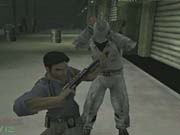
Of course, the control scheme also has its share of auxiliary commands, and they're mapped to the shoulder buttons. L1 allows you to crouch and sneak, while L2 allows you to circle-strafe your enemies, which works rather well. R1 and R2, finally, switch between the game's first-person perspective and its standard auto-targeting system. Head shots, though, can only be performed while in first-person mode, and Emerson promised that certain bosses will require you to use that perspective in order to attack their weak points.
But no good Hong Kong action story is complete without some steady doses of fisticuffs. Jack Slate will have a whole set of hand-to-hand attacks available to him, including punches, kicks, grabs, throws, and blocks. The system was still being implemented when we saw the game, so we didn't get to see a good deal of it. Emerson promised that there will be a good number of opportunities to put up your dukes, though, so don't fret.
Ballet of Bullets
Dead to Rights has several important systems built into it that help ensure that the onscreen action unfolds smoothly and dramatically. The game's targeting and camera systems are instrumental in making this happen. "From the onset, we decided that we needed to create a dynamic targeting system and also a camera system that would always show you where the threat is," Emerson explained. "It's really designed to make you feel as if you're on an even par with the enemies." So during play, the camera will automatically shift to allow you to see threats in front of you, wherever they may be. If enemies are shooting at you from a guard tower, for instance, the view will glide upward, revealing them. The character himself, also, will always turn his head in the direction of a threat. Even outside of combat, Jack will glance at key elements in the environments--switches, key items, and the like.
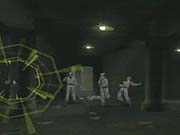
Targeting reticles, further, will appear around enemies, and they're color-coded to inform you about their range. A green reticule means that the target is out of range and, basically, that firing on them will result only in a waste of ammo. Yellow means they're a little closer, though not at optimal range. Red, finally, is the most serious threat marker--both parties can blast each other with deadly accuracy.
The camera will also act in more subtle ways. As you move through the environments, the camera will constantly shift, often providing both practical and dramatic effects. Ducking behind boxes, for example, will cue a tighter perspective that requires you to deliberately peek out from behind your cover. "We're really trying to up the sense of anxiety and tension for the player by doing something as simple as bringing the camera down with him [as he takes cover]," Emerson explained.
Along with the all the masterful technical work done for the camera and targeting systems are a set of well crafted AI routines. Emerson seemed pretty proud of them: "I think we're well on our way to creating a cool, challenging AI that's going to have a nice visual dynamic." Basically, the team wanted to avoid what it perceived as the tired behaviors of enemies in past third-person action games. Enemies, essentially, will either advance upon you or take cover. Some will even flank you. Things constantly go on during battles--enemies shift through the battlefield, some taking cover, others trying to rush you. Gone are static sequences, populated by prostrate human targets waiting to be filled with lead. "So many third-person action games' actual combat element feels like a shooting gallery," Emerson said. "It's like there are guys whose jobs it is to wait behind this crate for the hero to show up. That wasn't satisfactory for us. One of the things we set out to do was create an AI whose difficulty is scalable. [The enemies onscreen] will, depending on how we set them, always hunt you down, or they'll seek out cover. We're able to identify anything in the world as something that's safe for cover that the enemies will use. It's a really cool system." He then pointed out an enemy in the stage--whom he referred to as "somewhat of a coward"--that, after fleeing to the limits of his weapon's range, began to fire upon him from behind cover. As Emerson advanced upon him, surely enough, the enemy again fled and found new cover.
| "I think we're well on our way to creating a cool, challenging AI that's going to have a nice visual dynamic." |
Busting out, Busting Knots
Emerson has stressed that throughout the game, a handful of diversions, of sorts, will be presented to the player. One good example of this is the game's first stage. In place of the staid tutorial that starts most games, Dead to Rights has an altogether more compelling solution that provides the same service to you as the player: a full-featured prison break. "The unique aspect of the game's prison level is that there are no guns. I mean, it's prison, for crying out loud!" Emerson said. The series of sequences that make up the prison break will do much to introduce you to the game mechanics you'll need to master in order to make it through the game, the interesting part being the context in which you learn them. Emerson described it this way: "In the prison level, we essentially prepare the player for life outside of prison, through a series of minigames and puzzles. He'll end up being challenged to a weight-lifting contest, he'll have to deal with a speed bag, he'll end up arm wrestling, and we're talking about handball and a handful of other prison-type activities. And these won't only be stand-alone minigames--the types of mechanics involved in succeeding at those activities will be instrumental in future activities in the game. They're really preparing you for later sequences in the game." All of this you do in order to earn enough cigarettes to bribe an informant who's got word of the upcoming prison break. Each of the activities Emerson mentioned will have an actual gameplay-related analog outside of prison, though, truth be told, nothing that we've been exposed to immediately comes to mind. This leads us to believe that there's much about the game we still do not know about.
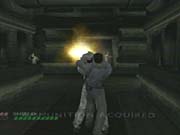
After you eventually break out of the joint, in any event, you can be assured that you'll meet with a good deal of unsavory characters. The worst of these will undoubtedly be the game's boss characters, who will also mix up the gameplay a great deal, as Emerson pointed out: "In the boss rounds, we're trying to do something really special. We're trying to do something that capitalizes on a lot of the classic old-school boss mechanics, but also using action-movie climatic themes for the fights themselves...In my opinion, on the bosses, it revolves around not just beating them, but whether you enjoyed the combat, and whether it was gratifying when you finally defeat them. Like the rest of the product, we're looking into areas other than games for what these confrontations could be [like]." Emerson feels that boss battles are highly compromised in most games--rather than being the intense climatic experiences they should be, they're often instead just prolonged battles with stronger and tougher foes. He feels that representing bosses in that way would unfairly compromise the narrative buildup associated with the characters: "To eliminate those characters in not-so-exciting ways kind of diminishes the whole point of having a story-driven buildup to your confrontation with them."
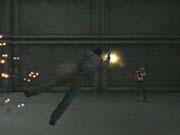
So what will these intense, Dead to Rights-style boss fights entail? Emerson is very tight-lipped about them as a whole, but he did throw us one tidbit of info to serve as an example of what's coming. He mentioned that, in one phase of one particular battle (and most boss fights will involve several phases), you'll find yourself pinned by an enemy many times stronger than you who's trying to drive a knife into your eye. "There's a particular set of mechanics for ensuring that that doesn't happen," Emerson told us, though he didn't go into any detail as to how they might work. He continued: "That's what I [mean about] trying to find climactic moments in film and almost pay homage to them by using game mechanics to try to bring those over-the-top sequences to life in real-time 3D." Perhaps your education in the big house will help out, after all...
Take Cover
Even though the game is still quite a ways from shipping (it's only been in technical development for about 10 months at the time of writing), it already looks and plays better than most finished products. It's very inspiring to see a large publisher providing its development team enough time and resources to get a game done right. But a large part of it has to do with the passion of the team. "We're way out from shipping, and I find people are here working late and on weekends," Emerson confided. "People are putting extra effort into this project because they want to. There's no me telling them, 'OK boys, give up your weekends, we've got to get this thing done!'" There's little doubt that their work will pay off.
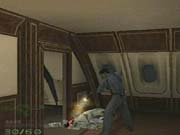
However, the presence of a thematically similar game on the horizon--namely, Max Payne--has certain people talking. Emerson, though, feels that the superficial similarities between the games matter little: "We don't get involved with [message-board-induced rivalry]. The bottom line is that Max Payne is a PC title first and foremost, and if it is shipping in the next couple of months, our title isn't shipping for many, many, many months. And our market can't sustain two products that share similar film influences? C'mon." In truth, it's unlikely that the two will seriously be competing products. At best, though, they could definitely make the public more receptive to games of their ilk, almost guaranteeing the commercial success of both. The downside, of course, is that it could inspire a boatload of inferior me-toos.
At any rate, it's almost a given that, if successful, every possible product will make its way onto every possible platform, and Dead to Rights is no different. While Namco isn't forthcoming about any definite plans at this point, Emerson did comment on the matter: "Ultimately, the dev team would obviously like to see the game get into the hands of as many gamers as possible, and it's all up to the financial folks upstairs to determine what's best. As far as we're concerned, though, the GameCube is looking really interesting, and the Xbox, well, we don't know enough about yet. But the PS2 is the working lead SKU for the product, though I wouldn't be shocked if we saw it go to other platforms." The outlook definitely seems positive.
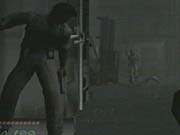
Ultimately, though, the game will ship for the PS2 first, and before anything else happens, its commercial success on that platform will definitely determine its future. But if the code's almost-impeccable state is any indication, success should be a short order. Emerson, anyway, left us with these thoughts: "I think what people have to look forward to is an amazing story-driven experience that we will make an effort to ensure captures the over-the-top gunplay and the heroic bloodshed of Hong Kong action films. I think that through a cleverly written story, a variety of mechanics, and incredibly cool bosses, puzzles, and minigames, we'll ensure that our pace feels right. I think it's a gamer's game, and anyone who's a fan of the [film] genre will really be excited about being the star."
Dead to Rights is looking like it'll be a pleasantly jarring hybrid of harsh and liberating gameplay elements and unprecedented visual dynamism. We haven't been this excited about a game in a very long time, and we really can't wait to get our hands on more of it. We'll definitely keep you updated. The game is set to ship at some undisclosed time next year.
Got a news tip or want to contact us directly? Email news@gamespot.com
Join the conversation